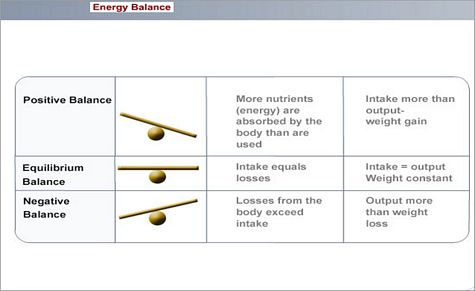| NUTRITION, ENERGY AND BODY WEIGHT |
| Information provided courtesy of Dietcare +2712 677 8115 |
All the functions of food in the body (growing and repairing body tissues, regulating body processes and supplying energy) are essential.
However, our first nutritional priority is for energy.
Without fuel, bodies will not be able to function, similarly as cars are not able to run without fuel. |
| Energy balance |
| Positive balance |
More nutrients (energy) absorbed by the body than are used |
Intake more than output: Weight gain |
| Equilibrium balance |
Intake equals losses |
Intake and output equal: Weight constant |
| Negative balance |
Losses from the body exceed intake |
Output more than intake: Weight loss |
|
|

|
| Why should we be concerned about our energy requirements? |
| Simply because, to maintain our weight, we need to keep energy requirements in balance with energy intake |
- When we take in more energy than we use, our bodies store away the excess in the form of fat, resulting in weight gain
- If we ingest less energy than we use, the body will withdraw some of the stored fats and we lose weight
- By weighing yourself, you are measuring the sum total of your body’s composition of bone, muscle, organs, water and fat
- Therefore, weight does not give an indication of how fat we are
- In the case of adults, measuring weight over time is a fairly reliable gauge that tells us how we are balancing our energy intake and output
- When weight remains fairly constant, it means energy intake and output are in balance
- When weight goes up, energy consumed is in excess of body requirements
- When weight goes down, energy intake is less than body requirements
|
| Energy imbalance |
If energy intake exceeds expenditure over a period of time, it is likely to result in obesity.
In this context, medical experts believe that a healthy weight should not be based primarily on body weight, but rather on the |
- Total amount of body fat
- Location of body fat
- Presence or absence of weight related medical problems
|
| Calculating ideal body weight |
| Using BMI (Body mass index) |
| To use this table, find your weight in pounds (1 pound=0.454kg) across the top row. Follow the column down to meet the box corresponding with your height. The number in this box is your BMI (body mass index). Then use your BMI to assess your health risk. |